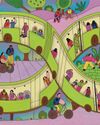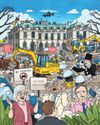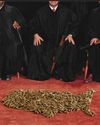
Alvin Taylor still remembers the sight each day as he’d return from school, of more houses in his neighborhood being burned to the ground. He was about 8 years old when the fires came for his home. Fenita Kirkwood recalls listening, as a 9-year-old girl, to her father arguing with men who had come to their doorstep to insist they had to leave. “That big yellow bulldozer pulled up in front of our house on a Friday,” remembers Lawrence Williams, who ran inside to fetch his mother. “I came in later and she was in the kitchen crying, asking God, ‘What are we going to do?’”
They were all children at the time, living in Section 14, a small plot of tribal land near downtown Palm Springs, California, in the mid-1960s. The city itself remained strictly segregated, and so their parents had helped to build a sort of shantytown out of trailers, wooden shacks, and small concrete dwellings—a mixed-race community that housed many of Palm Springs’ working-class Black residents. “We built a thriving community. There were businesses, churches…It was an actual village where people helped raise each other’s children, and we borrowed eggs from next door,” explains Pearl Devers, who was 12 years old when a change in federal law eased development restrictions on federal land—meaning there was significant money to be made by clearing residents from it.
The city condemned their properties, then proceeded to burn Section 14 to the ground. State officials later wrote that it amounted to a “city-engineered holocaust,” concluding, “Palm Springs ignored that the residents of Section 14 were human beings.”
This story is from the July/August 2024 edition of Mother Jones.
Start your 7-day Magzter GOLD free trial to access thousands of curated premium stories, and 9,000+ magazines and newspapers.
Already a subscriber ? Sign In
This story is from the July/August 2024 edition of Mother Jones.
Start your 7-day Magzter GOLD free trial to access thousands of curated premium stories, and 9,000+ magazines and newspapers.
Already a subscriber? Sign In

HOG WILD
The scandalous reason meat prices have skyrocketed

ALL WALKS
Limiting cars in cities can help disabled people, too.

REMIGRATION
How Trumpism is following the far right in Europe toward mass expulsion of immigrants

SETTLING THE SCORE
A pop psychology book is considered the definitive trauma text. But what if it's leading survivors down the wrong path?

Positive Spin
People with e-bikes drive less, pollute less, parkinglots-and that's only part of why cities and states are embracing them with gusto.

Cradle and All
The devastating cost of Utah's thriving adoption industry

THE BILLIONAIRE WHO NEARLY BROKE NEWPORT
TRUMP MEGADONOR STEPHEN SCHWARZMAN'S EXTREME MANSION MAKEOVER IS DRIVING HIS NEIGHBORS NUTS.

THE SECRET PLAN TO STRIKE DOWN US GUN LAWS
AND THE COP-TURNED-PASTOR AT THE CENTER OF IT ALL

GOOD NIGHT AND GOOD LUCK
Election Day inside a bustling broadcast newsroom that no longer exists

MASTER OF DISASTER
Trump won’t confront the climate crisis. He’ll feast off it.